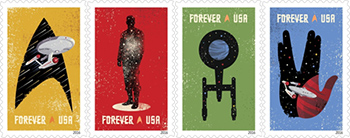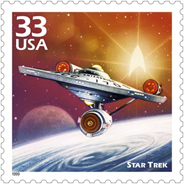
WASHINGTON — Nearly 50 years to the day of the original airing of “Star Trek,” the U.S. Postal Service dedicated the Star Trek Forever stamps today at New York City’s Jacob K. Javits Convention Center. The first-day-of-issue ceremony launched Star Trek: Mission New York, a three-day celebration that is expected to draw thousands of Star Trek fans.
These stamps will “live long and prosper,” because as Forever stamps they are good for mailing a 1-ounce First-Class letter anytime in the future — regardless of star date. “Star Trek” fans are asked to share the news on social media using the hashtag #StarTrekForever.
“The Postal Service is proud to commemorate ‘Star Trek’ on the eve of its 50th anniversary,” said Postmaster General Megan J. Brennan referring to the iconic television program’s Sept. 8, 1966, debut. “Star Trek’s intricate futuristic setting, multicultural cast and story lines touched on social issues and pushed past the boundaries of popular science fiction becoming a worldwide phenomenon.”
Joining Brennan in dedicating the stamps were actor and humanitarian Walter Koenig, who portrayed U.S.S. Enterprise’s navigation officer Pavel Chekov in the series; NASA Deputy Director of Science for Communication Michelle Thaller; CBS Consumer Products Executive Vice President and General Manager Liz Kaloduer; and, U.S. Postal Service Chief Postal Inspector Guy Cottrell.
“With the chaos in today’s world, hopefully the stamps and what they signify can inspire a better future for us all,” said Koenig.
“’Star Trek’ gave us a universe that we could explore in our imagination,” said Thaller. “In this universe we pioneered not only new technology and new worlds, but — more importantly — new social rules and new definitions of tolerance and diversity. In Star Trek’s universe, we found better ways to be human.”

The stamps, under license by CBS Consumer Products, showcase four digital illustrations inspired by classic elements of the television program:
- The Starship Enterprise inside the outline of a Starfleet insignia against a gold background;
- The silhouette of a crewman in a transporter against a red background;
- The silhouette of the Enterprise from above against a green background; and,
- The Enterprise inside the outline of the Vulcan salute (Spock’s iconic hand gesture) against a blue background.
The words “SPACE… THE FINAL FRONTIER,” from Captain Kirk’s famous voice-over appears beneath the stamps against a background of stars. The stamp images were created by the design firm Heads of State of Philadelphia, PA, under the art direction of Antonio Alcalá of Alexandria, VA.
“Star Trek” celebrates its 50th anniversary in 2016. Born from the mind of Gene Roddenberry, the original “Star Trek” series aired for three seasons — a short run that belied the influence it would have for generations. The series also broke new ground in storytelling and cultural mores providing a progressive look at topics including race relations, global politics, the environment and more. It spawned five more television series and 13 feature films spanning the course of half a century.
Beyond its impact on the entertainment landscape, “Star Trek” has also influenced our modern world by helping spark technological advancements such as the cell phone, universal translator, smart watch, tablet, sonogram and other inventions.
Ordering First-Day-of-Issue Postmarks
Customers have 60 days to obtain the first-day-of-issue postmark by mail. They may purchase new stamps at local Post Offices, at The Postal Store website at usps.com⁄shop, or by calling 800-782-6724. They should affix the stamps to envelopes of their choice, address the envelopes to themselves or others, and place them in a larger envelope addressed to:
Star Trek Stamps
Special Events Coordinator
380 West 33rd Street
New York, NY 10199-9998
After applying the first-day-of-issue postmark, the Postal Service will return the envelopes through the mail. There is no charge for the postmark up to a quantity of 50. There is a 5-cent charge for each additional postmark over 50. All orders must be postmarked by Nov. 2, 2016.
Ordering First-Day Covers
The Postal Service also offers first-day covers for new stamp issues and Postal Service stationery items postmarked with the official first-day-of-issue cancellation. Each item has an individual catalog number and is offered in the quarterly USA Philatelic catalog, online at usps.com⁄shop, or by calling 800-782-6724. Customers may request a free catalog by calling 800-782-6724 or writing to:
U.S. Postal Service
Catalog Request
PO Box 219014
Kansas City, MO 64121-9014
Visit this link for information on upcoming stamp events.
The Postal Service receives no tax dollars for operating expenses and relies on the sale of postage, products and services to fund its operations.
™ & ©2016 CBS Studios Inc. STAR TREK and related marks and logos are trademarks of CBS Studios Inc. All Rights Reserved.
# # #
Please Note: For broadcast quality video and audio, photo stills and other media resources, visit the USPS Newsroom.
Reporters interested in speaking with regional Postal Service public relations professionals should visit this link.
Follow us on twitter.com/USPS and like us at facebook.com/USPS. For more information about the Postal Service, visit usps.comand usps.com/postalfacts.
‘Star Trek’ Background Information
To Boldly Go Where No Man Has Gone Before
On Sept. 8, 1966, “Star Trek” premiered. Centered on the interstellar voyages of the U.S.S. Enterprise, the prime-time television program's mission was “to boldly go where no man has gone before.”
The idea for “Star Trek” came from the mind of writer and producer Gene Roddenberry. Born in Texas in 1921, Roddenberry penned scripts for several shows, including “Dragnet.” In the mid-1950s, he entered the TV world full-time and became a prolific writer. In the early 1960s, he created the military drama “The Lieutenant,” which aired for one season on NBC.
As production on “The Lieutenant” wound down, Roddenberry was developing a program about a starship called the S.S. Yorktown and its crew. In his initial outline, Roddenberry compared Star Trek to the western action and adventure series “Wagon Train.” Several studios turned down the idea before Desilu, the production company founded by Desi Arnaz and Lucille Ball, signed Roddenberry to a contract and began shopping “Star Trek” to the networks. NBC eventually agreed to finance a pilot episode.
The production staff took great care in building the “Star Trek” universe, hiring notable science fiction authors to pen scripts and hiring a scientist as a technical advisor. Set designers devised both the exterior and interior of the Enterprise — which Roddenberry initially had named the Yorktown — and also gave it the registry number NCC-1701. Props such as the cell phone–like communicator and the tricorder, a handheld scanning computer, provided viewers a glimpse into the future. But no piece of fictional technology on Star Trek was as iconic as the transporter, which “beamed” characters from one place to another.
Two Pilot Episodes
The pilot was titled “The Cage,” and featured Captain Christopher Pike. However, in a highly unusual move, NBC commissioned a second pilot. The show was recast with the notable exception of Spock, a pointy-eared, supremely logical half-alien officer who hailed from the planet Vulcan.
Captain Pike was replaced with Captain James T. Kirk. Roddenberry added a multicultural cast around him, including both Japanese helmsman Hikaru Sulu and Scottish Chief Engineer Montgomery Scott. Communications officer Alden was the Enterprise’s first African-American crew member.
The second pilot, “Where No Man Has Gone Before,” focused on thwarting two crew members who accidentally acquired mysterious godlike powers. The title of the episode became part of Kirk’s famous introductory voice-over:
“Space: the final frontier. These are the voyages of the Starship Enterprise. Its five-year mission: to explore strange new worlds, to seek out new life and new civilizations, to boldly go where no man has gone before.”
This time, the thoughtful but action-oriented story won over NBC, which commissioned the series for the 1966–67 television season. Communications officer Alden departed and Lieutenant Uhura came aboard as the new communications officer. The character was one of the first strong roles for an African-American woman in television history.
Chief Medical Officer Leonard “Bones” McCoy also was added and fans warmed to him after he became the focal point of “The Man Trap,” the episode that served as the series premiere.
During its run on NBC, “Star Trek” deftly combined action, adventure, drama, fantasy and allegory. An early episode, “Errand of Mercy,” about an escalating conflict between the United Federation of Planets and the Klingon Empire, took on the Cold War. Other episodes alluded to the Vietnam War, the population explosion, the growing generation gap and race relations. (“Plato’s Stepchildren” featured TV's first high-profile scripted interracial kiss between Kirk and Uhura.)
“Star Trek” was so globally influential that an article in the Soviet newspaper Pravda complained that the Enterprise’s international crew lacked a Russian. For the show’s second season, Roddenberry responded by introducing young Pavel Chekov.
One of the show’s most beloved episodes, “The City on the Edge of Forever,” involved Kirk and Spock traveling back in time to America during the Depression. It won a Hugo Award for Best Dramatic Presentation, while the original teleplay won a Writers Guild of America Award.
By the end of the 1960s, “Star Trek” had become wildly popular. Nonetheless, it was canceled at the conclusion of its second season. But the decision did not stand. Thousands of people sent letters to NBC in support of the show, which NBC picked up for a third season. Fans often repeated lines heard on the program and performed Spock’s iconic Vulcan salute.
NBC canceled “Star Trek” after three seasons, but the show soon entered syndication and grew even more popular. By the 1970s, “Star Trek” fans had begun organizing clubs, publishing tribute magazines and holding conventions.
Soon, the once fledgling science fiction program became a franchise. Filmation produced the Emmy Award–winning “Star Trek: The Animated Series,” which featured the voices of the original cast members and aired on NBC in 1973 and 1974. The Paramount Pictures–produced “Star Trek: The Motion Picture” (1979) was the first of six films to star the cast of the original series.
The Next Generation
In 1987, “Star Trek: The Next Generation” premiered. Produced by Paramount and aired in first-run syndication, the television series introduced a new crew of adventurers who also appeared together in four films. A trio of “Star Trek” TV series followed in the 1990s and 2000s: “Star Trek: Deep Space Nine,” “Star Trek: Voyager” and Star Trek: Enterprise.
By that time, “Star Trek” had long since become an American institution. In 1992 and 1993, people flocked to the Smithsonian’s National Air and Space Museum in Washington, DC, to explore an exhibit dedicated to the phenomenon.

In 1999, an illustration of the Starship Enterprise appeared on a U.S. postage stamp as part of the Celebrate The Century: The 1960s issuance.
In 2009, the enduring entertainment icon was given a reboot with the film “Star Trek.” The franchise continued with “Star Trek Into Darkness” (2013) and “Star Trek Beyond” (2016). Fifty years after the debut of the original television series, “Star Trek” continues to capture the imagination of the public.

